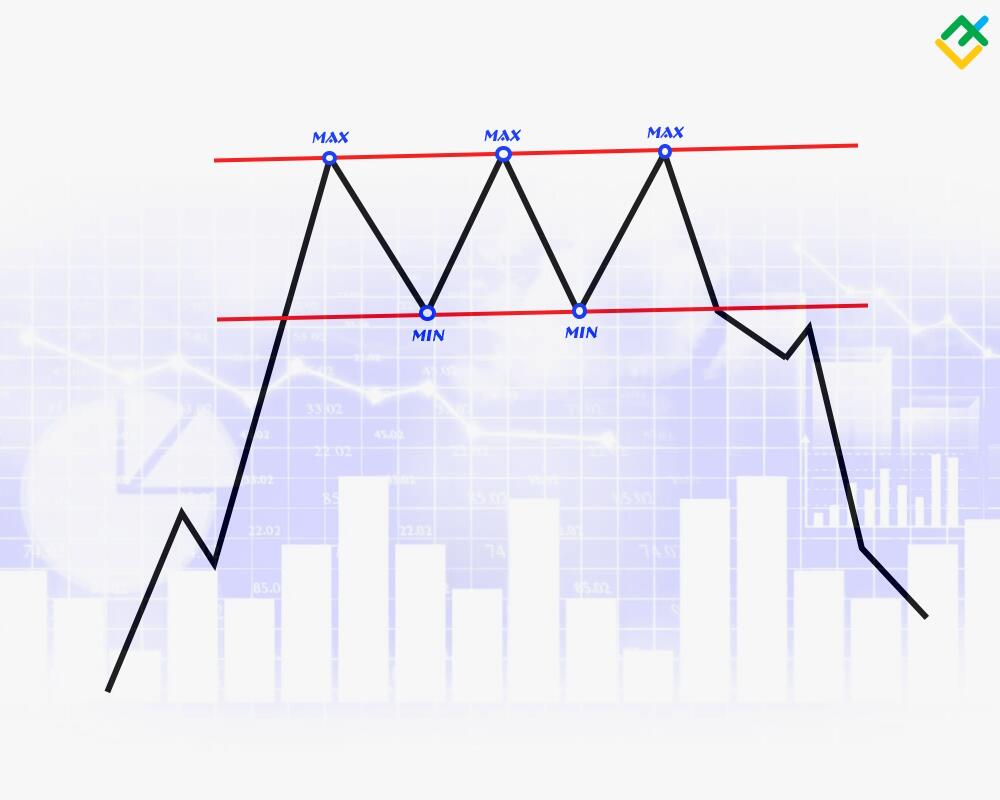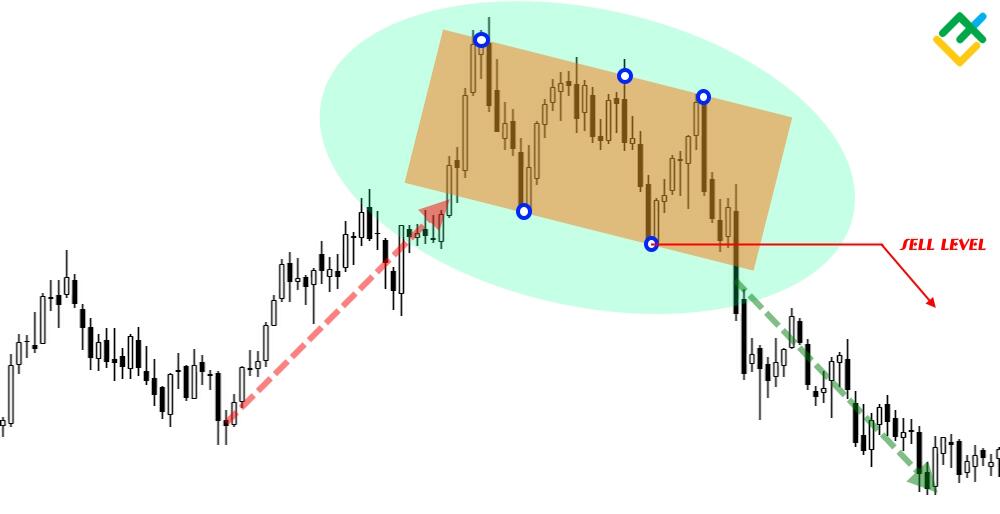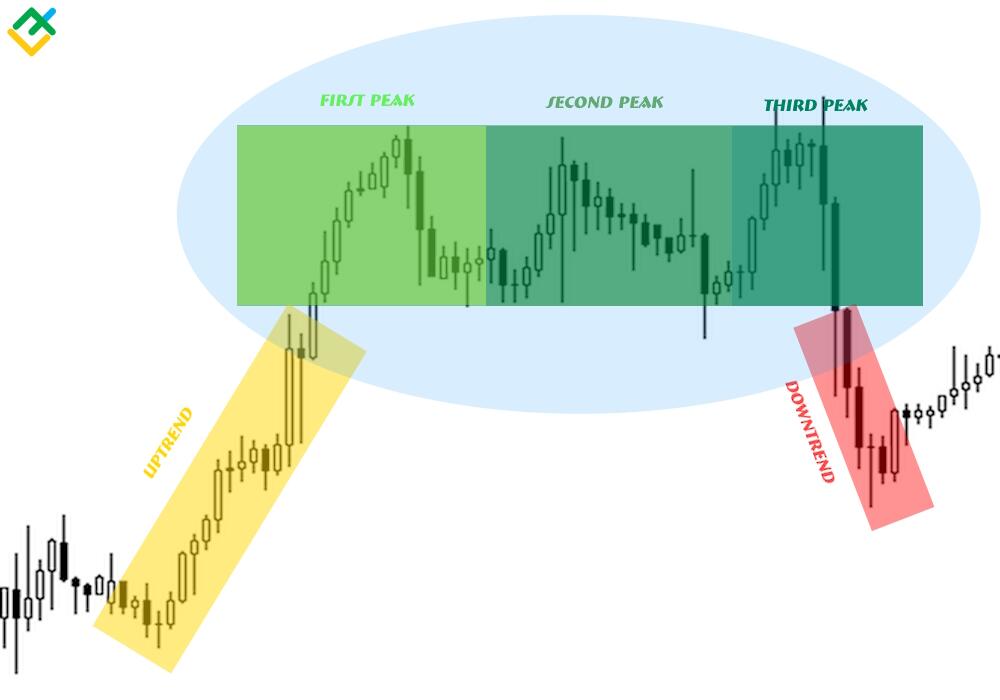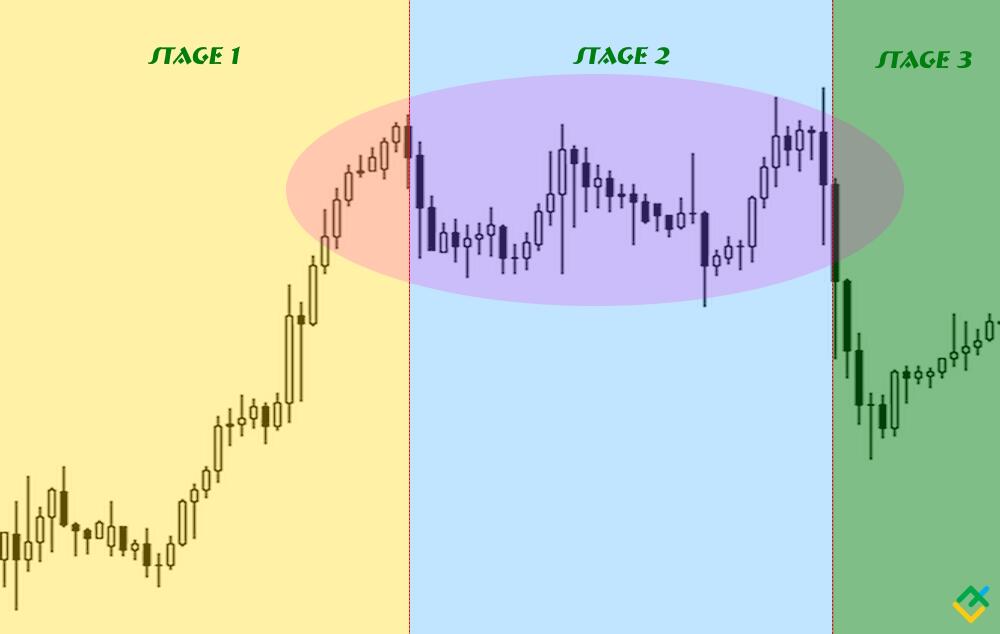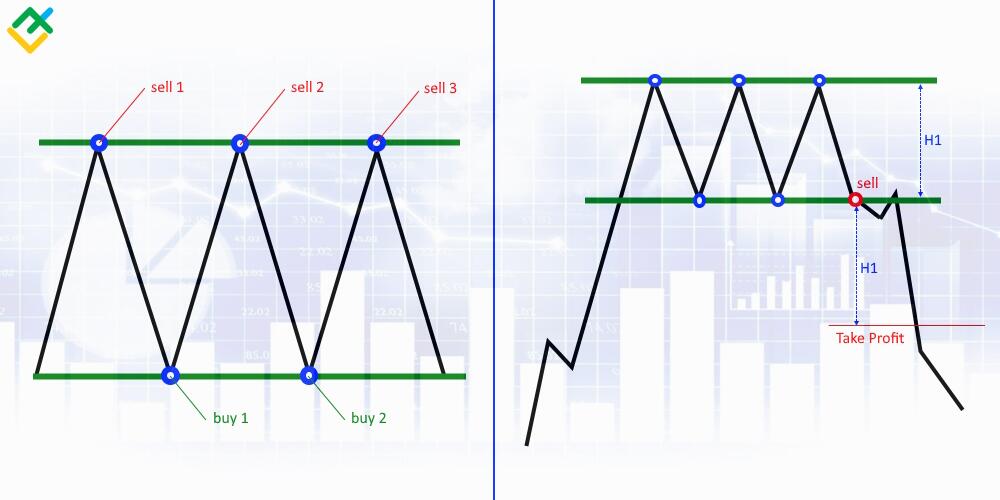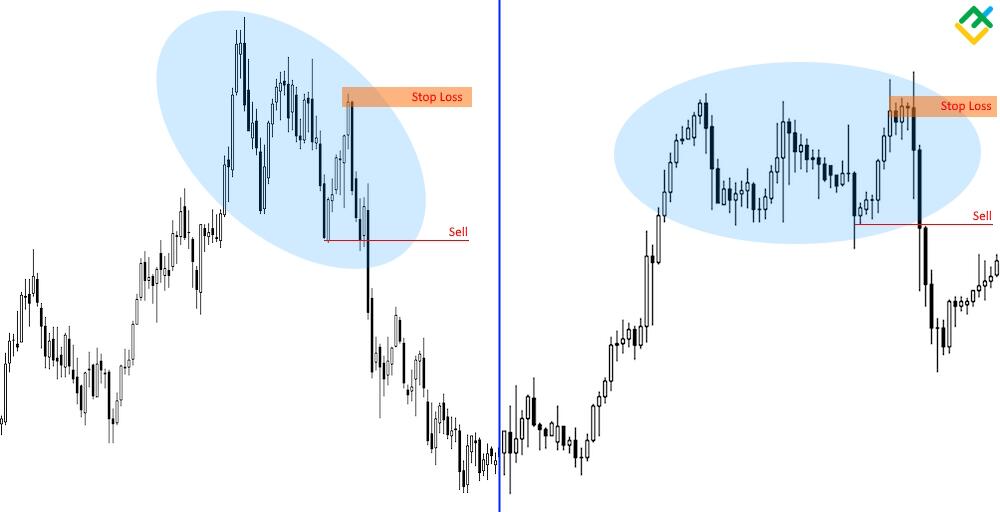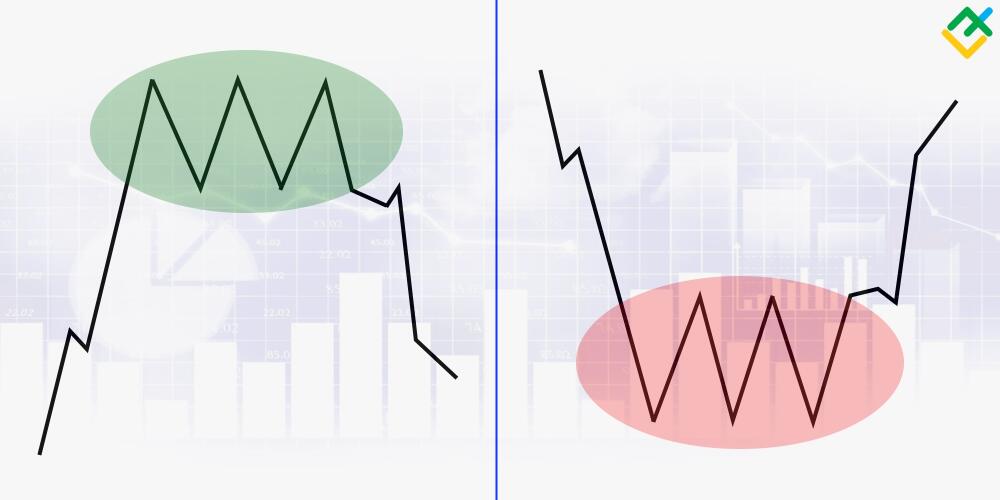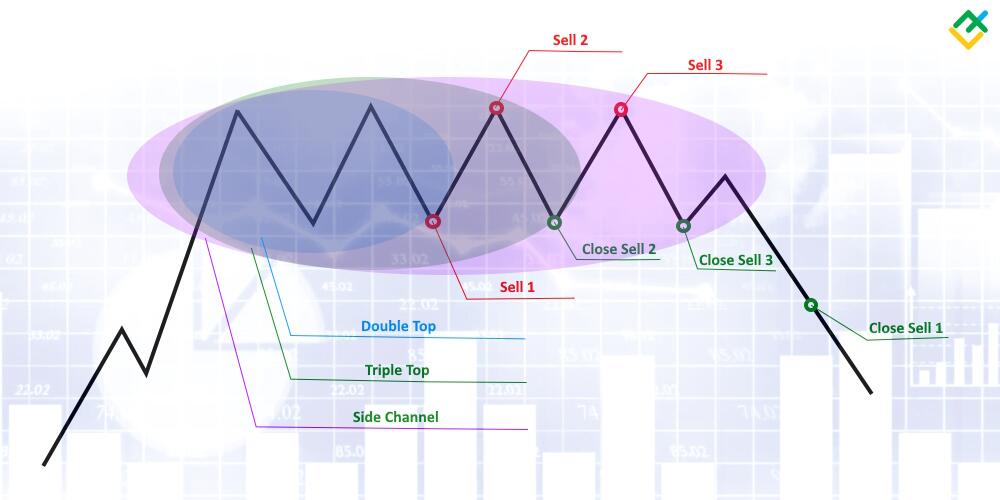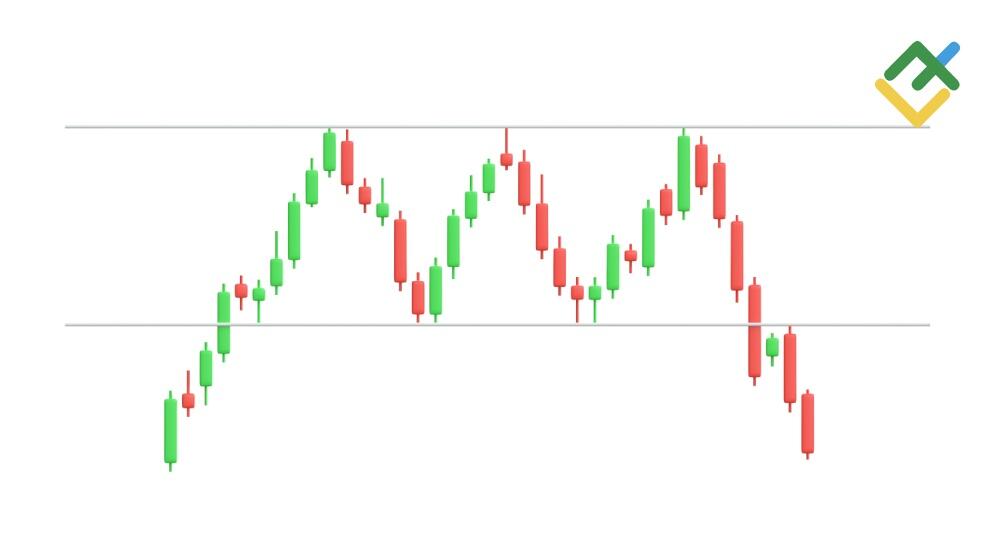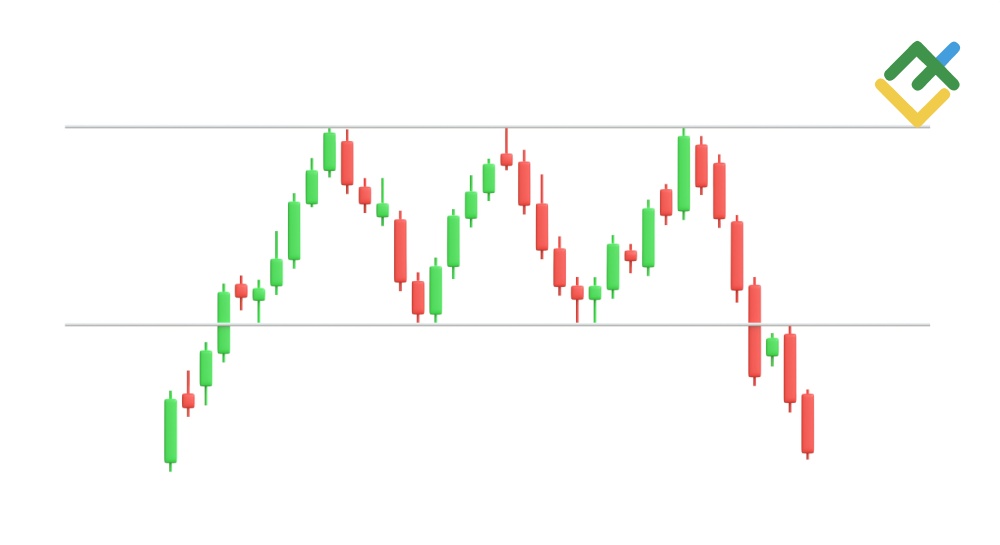
Using technical analysis in trading is often limited to analyzing price chart patterns, with price action patterns being the most common subtype. More than 50 chart patterns are currently known, but there are popular patterns that can be found on any time frame. Such patterns include the triple top and triple bottom patterns.
Although triple bottoms and triple tops are the same chart pattern, traders use the triple bottom more often due to this pattern psychology: buying is psychologically easier than selling.
The article covers the following subjects:
Key Takeaways
|
What is a Triple Top Chart Pattern? |
A triple top is a chart pattern that signals a bullish to bearish sentiment shift after a continued uptrend. |
|
What is the difference between triple bottoms and triple tops? |
A triple top pattern forms on peaks after a bullish trend, while a triple bottom occurs after a decline. |
|
How does the pattern affect the market? |
A triple top formation belongs to reversal patterns and occurs at a trend’s end, signaling a potential trend reversal. |
|
How does the pattern work? |
A trader sets a pending order to sell slightly below the pattern’s two previous lows. |
|
How to spot the pattern on the chart? |
The triple top visually represents three consecutive peaks at the end of an upward trend that look like a channel. These three peaks must be approximately the same size in points. |
|
Peculiarities of the pattern |
The triple-top pattern is often misinterpreted as the head and shoulders pattern. Even if it happens, the two patterns work similarly. |
|
Triple Top trading advantages |
The triple top pattern offers a simple structure and clear stop levels, and it works on any time frame. |
|
Triple Top trading disadvantages |
Small chance of complete formation. This rare chart formation is also able to transform into a continued channel. Acceptable stop loss values are fairly large. |
|
Best time frames |
The triple top pattern provides reliable signals on any time frame, but the validity increases on bigger chart periods. |
|
Stop Loss levels |
Stop orders can be set anytime and are often linked to the pattern’s highs and lows. |
What is a Triple Top Chart Pattern?
The triple top candlestick pattern, or “triple tops,” is a chart pattern used in technical analysis that occurs on an uptrend‘s peaks. If it forms completely, an uptrend reverses down.
This is a bearish reversal pattern that forms in price charts of any assets and belongs to basic chart formations. Although it can form on any time frame, this pattern works best on an H4 time frame and larger, like most technical analysis patterns.
A triple top pattern is a reversal pattern that forms three consecutive price peaks on the same resistance level after a steady bullish trend, building a small channel with a solid resistance level.
This channel can be downward, upward, or sideways. The main condition is that the three peaks must be the same size in points.
How a Triple Top Works
The pattern forms in a chart after an uptrend’s strength starts fading out, and a slowdown stage begins. This stage is determined by the patterns of triple top, double top, and head and shoulders.
The pattern’s first peak is normally the highest, and the price heads down after its formation. When a pullback ends, the price rallies and gradually forms three consecutive peaks, looking like a channel.
This chart pattern is completely formed once the pattern support line is broken and the price drops below the previous low. Then, you can start selling as the previous trend is regarded as completed. Thus, the triple top pattern signals a trend reversal to the downside.
Importance of trading the Triple Top Pattern in Technical Analysis
In modern technical analysis, the triple top pattern stands out among other price formations.
- It helps identify a potential change in market sentiment from bullish to bearish. After the pattern forms completely, the price crosses the previous local low from above to below—the main reversal signal. Spotting this pattern, traders can predict an upcoming reversal.
- A triple top is an important part of price formation theories like Elliott Wave Theory. This theory describes types of corrective waves, including flat waves—narrow channels to which a triple top belongs.
- Triple tops are the basic element of most chart patterns. Historically, the triple top pattern is one of the earliest technical analysis patterns, and the more popular Head and Shoulders pattern is its variation.
Spotting and Identifying the Triple Top Pattern
To correctly identify this pattern on a price chart, you should ensure that the first and second formation stages are fully completed. Only after all three peaks have formed can we say we are dealing with a triple top pattern. However, even if all three peaks have been spotted, the pattern may not work and turn into a regular channel.
Additionally, there are a few candlestick patterns that work and look similar. The most common case is when a triple top continues a double top pattern. The second most popular pattern is head and shoulders, which differs from the triple top chart pattern only in that its central peak must exceed the value of the other two. Thus, a triple top pattern has a few distinctive features:
-
All three peaks must be approximately the same size in points.
-
Support and resistance lines drawn through the pattern’s troughs and peaks must be almost parallel.
-
A triple top pattern occurs only after a robust uptrend ends and cannot be a sideways trend’s continuation.
Parts of a Triple Top Pattern
Before forming completely, a triple top goes through a few stages like any other technical analysis pattern. A triple top pattern consists of three parts:
-
Uptrend. This pattern occurs only after a pronounced uptrend, on the tops of which it forms. The earliest mentions of this pattern highlight that an uptrend’s size must be at least two times more than the channel formed by the triple top.
-
Channel formation. Once the first peak has formed, trade volumes fall significantly, and the trend changes to a flat range. This sideways trend may take longer to develop than the previous uptrend. The pattern’s limits are marked by drawing lines through its lows and highs, similar to support and resistance levels. The price breaks the support line at the end of the channel formation.
-
Bearish trend. This is the final stage of formation, associated with a subsequent price fall. When the price drops below the previous trend low, the channel will break, and the trend will reverse to the downside.
Trading Triple Top Patterns: Strategies and Considerations
Although there exist many strategies for trading the triple-top pattern in modern technical analysis, only two are most widely used.
-
Inside Pattern Trading Strategy. This triple top trading strategy involves trading within the price range, as the pattern is sometimes mistaken for a regular channel. Trades are executed between the support and resistance levels. The classic version suggests three trades within the pattern. The first sale occurs after the formation of the second peak. Then, long positions are opened at the second low, and the final trade involves selling at the third peak of the pattern, having shifted the trade to breakeven after reaching the second low. Less cautious traders make up to five trades within the pattern, but making transactions from the first highs and lows may be very risky.
-
Classical trend reversal strategy. The most popular and much safer strategy is trading a breakout of the low by opening one sell trade after all three peaks have formed. After the price drops and breaks the pattern’s support line, the trader measures the pattern height in points (or the height of any of the pattern’s ‘hills’), which is then subtracted from the breakout point. This is the potential sell target. However, some traders often move the trade to breakeven when the price covers more than 80% of the expected decline and then place a trailing stop order.
Stop Loss Placement for Triple Top Pattern
Placing stop orders is largely similar to other technical analysis patterns and depends on identifying the pattern’s highs or lows.
With a triple top, a stop loss is always set at or slightly above the high that preceded the support level breakout. The most important thing to understand here is that the slope of the pattern does not matter. The stop loss will always be at the third peak of the pattern. The disadvantage of this method is that the stop loss value in points is usually equal to the expected take profit value, which is not an acceptable profit/loss ratio.
For more precise adjustment, the stop loss level can be corrected and moved above the price high to the level of the trading instrument’s “market noise.” However, much depends on the time frame: such adjustments will not be effective on time frames shorter than H4, as the stop value often exceeds the expected profit.
Start trading with a trustworthy broker
Volume Analysis in Triple Top Patterns
Another element of market analysis based on the triple top pattern is the trading volume analysis.
According to the pattern formation theory, trading volumes are at their highest upon reaching the first peak, which can continue until the support line is broken.
The trading volume should decrease to 50%-70% of the first peak’s volume at the moment of the second peak formation. The third peak forms amid the lowest trading volumes: the indicator can fall to 20% of the initial volume. When the support line is broken and a trend change occurs, the trading volume increases sharply.
When analyzing trading volumes, remember that the Forex market trading volumes are different from derivatives trading volumes. Forex uses tick volumes, representing the number of price fluctuations per unit of time. In contrast, the stock market operates with real volumes determined by money supply. All principles of the pattern formation are based on real volume, not tick volume.
Triple Top vs. Triple Bottom Patterns
Almost every bearish reversal pattern has its bullish reversal counterpart in the market. Let’s compare the key parameters of the triple top and triple bottom patterns.
|
Parameter |
Triple Top |
Triple Bottom |
|
Entry direction |
The pattern begins forming after a pronounced uptrend |
The triple bottom pattern is a bullish pattern that forms after a pronounced downtrend |
|
Key points |
The pattern’s key points are three consecutive price peaks |
The pattern’s key points are three consecutive price lows |
|
Exit direction |
Upon pattern formation, a trend reverses down |
Upon pattern formation, a trend reverses up |
|
Breakout point |
The breakout point is the support line breakout |
The breakout point is the resistance line breakout |
|
Stop Loss |
A stop loss order is set at a peak preceding the breakout point |
A stop loss order is set at a low preceding the breakout point |
|
Take Profit |
A Take Profit value equals any of the pattern’s three peaks |
A Take Profit value equals any of the pattern’s three troughs |
|
Best time frames |
The pattern can form entirely on any time frame, but the most efficient ones are H4 and D1 |
The pattern works on any time frame, but the most efficient ones are H4 and D1 |
|
Occurrence rate |
This pattern often forms in a price chart |
This pattern often forms in a price chart |
|
Efficiency |
A triple top pattern has a 65% likelihood of forming completely. |
A triple bottom pattern has a 65% likelihood of forming completely. |
Pros and Cons
Although the triple top pattern is identified on price charts quite frequently, the probability of its full formation is low. Still, its ease of use has made it one of the most popular in technical analysis.
|
Pros |
Cons |
|
The pattern is universal. It can be identified on any period and for any assets, from currency pairs to commodities. |
Low probability of full formation. The probability that the figure will fully form barely exceeds 65%. This is much inferior to other indicators and chart patterns, for example, double tops and bottoms. |
|
Very easy to use. The pattern involves only three levels of orders, so even a beginner will understand where to set them. |
It can be easily confused with other patterns. The pattern is also mistaken, for example, for the head and shoulders pattern. If that’s the case, your profit levels may be too small. |
|
The pattern can be adjusted. The pattern’s signal to enter the market lags and becomes relevant when almost all other signals indicate a trend reversal, which increases the chances of success. |
Weak profit potential compared to a potential loss of money. Stop Loss and Take Profit levels are equal, which does not comply with money management parameters (a 3:1 profit/loss ratio is recommended). |
|
The triple top signals a market reversal and is not a signal to open a trade. |
It often occurs on big time frames, so the pattern takes months and even years to form. |
Benefits of Using the Triple Top Pattern in Trading Decisions
Pattern trading is a significant part of technical analysis and is quite popular among novice traders. However, working with this pattern has some clear advantages:
- The pattern provides a bearish signal that indicates a market reversal. Since the pattern appears at the top of the market when buyers’ trading volumes are no longer so high, it can be used quite successfully as a reversal indicator.
- The triple top’s signal to enter the market is very easy to spot. The market entry level is linked to the lowest price within the pattern. This low is easy to identify and nearly impossible to misinterpret, which simplifies the market entry process.
- The pattern can work as a regular channel. Even if you misidentified the pattern and it transformed into a regular channel, the probability of a trend reversal will remain. No matter how long your trade is active, the chances of its realization are high.
- The pattern is easy to confirm. Basic reversal patterns can be easily confirmed using volume technical indicators, such as MACD or AO.
- Clear order levels. The triple top is very easy to automate. Order levels can be set before entering a trade, as they are linked to the lows and highs that have formed long before the entry point.
- The pattern can be incorporated into global strategies. Triple tops are used in technical analysis as part of strategies like Elliott Wave Theory. In this case, the pattern can be effectively used to confirm corrective waves.
Limitations and Risks of Trading Triple Top Patterns
Trading on world exchanges comes with some risks in general, and trading a triple top is no exception:
- Although the triple top pattern is a bearish reversal pattern, it does not always accurately indicate a reversal. There are often situations when the pattern transforms into a regular channel with more than six waves. In this case, early sell positions may close with a loss.
- Market noise can obscure clear entry signals. The market entry level is linked to the lowest price within the pattern. However, slippage or touches may occur when the price approaches it, after which the price rallies again.
- The pattern is easy to confuse with others. Novice traders often confuse the triple top with the head and shoulders pattern, so market entry and exit levels may be determined incorrectly.
- Low probability of full formation. Few are patterns with a profitable trade ratio above 80%, and the triple top is not one of them, barely exceeding the 60% profit/loss ratio.
Real-World Examples and Case Studies
While trading with patterns, I’ve had many situations that did not follow the rules for trading this pattern. Some of them resulted in losses, while others yielded unexpected profits.
Case 1
After the pattern forms, the price is expected to drop sharply, but instead, a rebound occurs, followed by the formation of a channel. This can trigger a sell order, but the position becomes unprofitable due to a false breakout.
To avoid this, place an order below the pattern’s local low at a distance roughly equal to the market noise. This method works perfectly on large time frames, sifting out up to 90% of false breakouts. However, if your expected profit is insignificant, up to 1,000 points, your potential profit will significantly decrease.
Case 2
The price does not often reach the expected profit, which can affect the margin. There are two solutions: move the stop loss to breakeven and place a trailing stop upon reaching 50% of the profit. The downside of this method is that the price can reverse and test the previous low, resulting in your trade closing without any profit. You can partially lock in profits or close a trade when 80% of the profit is reached. I prefer the second solution since a trailing stop can close the trade without profits.
Case 3
This pattern continues the double top formation but can transform into a long sideways trend. I suggest the optimal trading strategy when working with this pattern.
Since this figure continues the double top pattern, I open a sell position after reaching the second peak.
-
After the second peak, a short position, Sell 1, is opened.
-
If the price falls, we close the trade with a profit from the double top pattern.
-
If the price starts growing, we open another short position, Sell 2, at the price level of the first peak.
-
If growth continues and a pattern breakdown occurs, both trades will be closed by the stop loss order.
-
If the price reverses and the third peak is formed on the chart, we close the Sell 2 trade at the price level of the second low.
-
If the triple top pattern forms, we close the Sell 1 position with a profit.
If the pattern breaks and transforms into a channel, we can continue to open trades at new peaks until the price exits the channel. The longest channel I have had included eight trades and seven of them were closed with profits.
Combining the Triple Top Patterns with Other Technical Indicators
As described above, the pattern is easily confirmed by technical indicators, which, when combined, can signal changes in trading volumes. In general, indicators and graphic patterns complement each other well.
By adding an indicator, you can transform the pattern into a fully developed strategy, where both the pattern and the indicator confirm the entry signal into the market.
Volumes Indicator
The most common option is combining our pattern with the Volume indicator.
This indicator looks like a series of colored bars. A decrease in volume relative to the previous bar is marked with a red bar, while an increase is marked with a green bar.
First, identify reversal points at the pattern’s peaks. The first red bar after a series of green ones signals the formation of a peak. Each subsequent reversal bar at the peaks should be lower than the previous one, which indicates decreasing volumes within the pattern. It is believed that some buyers are sifted out after each new peak, and the volumes fall. A sharp increase in trading volumes signals the beginning of the pattern formation, which confirms the market entry point.
Stochastic Oscillator
Another option is combining the pattern with a Stochastic Oscillator.
This indicator consists of two parts. The first is a line based on the exponential moving average (EMA) that points out an increase and decrease in traders’ demand, and the second part is overbought and oversold zones.
When the EMA enters the overbought zone, bullish volumes decline, which can drive the formation of the pattern highs. Exiting the overbought zone may mean a technical reversal. Reaching the oversold zone often signals the formation of lows. Finally, if the EMA remains long in the oversold area, this may indicate the start of the pattern’s formation.
Combination of MACD and Awesome Oscillator
The third option is combining Moving Average Convergence Divergence and Awesome Oscillator.
I have been using this combination for a long time and find it to be the most reliable. I should mention that only one indicator is used, depending on the time frame of the triple top pattern. If these are time frames shorter than H4, AO is used. From D1 and higher, MACD is better suited.
At first glance, the price chart and the indicator look almost identical. The indicator accurately displays the chart’s highs and lows. We just need to wait for three peaks to form on the chart, which the indicator will correspondingly indicate. A sell position is opened when the indicator crosses 0, falling into the sales zone.
Remember: all three peaks on the indicator must be above the 0 level when we deal with a triple top. For the triple bottom pattern, all three troughs must be below the 0 level.
Start trading right now
Conclusion
Pattern trading is one of the most popular methods among small and medium capital traders. Patterns are easily spotted on the chart as their formation levels are clearly pronounced.
The triple top pattern is one of the most popular. Once you have learned to use it correctly, you can build profitable trading strategies. To make your trading even more effective, follow a few tips.
First, trade only those patterns that occur on time frames longer than H1. The H4 time frame presents the highest probability of this reversal pattern formation. Also, do not wait for Take Profit to work completely: if the price has covered more than 80% of the projected direction, close the trade.
FAQs on Triple Top Chart Pattern
The appearance of the triple top pattern on the chart suggests that the ongoing upward move will soon change to a downtrend. The market is overbought, and the bulls are phasing out positions.
A triple top pattern is a bearish reversal chart pattern, as it forms amid growing sell volumes. A trade that marks the end of this pattern formation is a short position (sell).
The likelihood of fully forming the Triple Top pattern ranges from 60% to 70%, depending on the specific variation of the pattern. The ascending channel is the most effective variation. However, it is not the most accurate pattern compared to other price action formations.
The triple top pattern continues the double top pattern, but this pattern is considered more reliable as its resistance level gets tested three times instead of two.
The triple top pattern can be confirmed using technical indicators. The most typical confirmation methods involve sifting out decreasing volumes with the Volume indicator and watching for a move toward the zero level on the MACD indicator.
The pattern works across all time frames, but its accuracy improves with larger time intervals. The higher the time interval, the higher the probability of formation. The most popular periods are H4 and Daily time frames.
Identifying a triple top pattern following a downtrend suggests that the triple bottom pattern preceding it is either evolving into a channel or testing the resistance line. Short positions should not be opened in this case.
The content of this article reflects the author’s opinion and does not necessarily reflect the official position of LiteFinance. The material published on this page is provided for informational purposes only and should not be considered as the provision of investment advice for the purposes of Directive 2004/39/EC.
{{value}} ( {{count}} {{title}} )
This post is originally published on LITEFINANCE.

